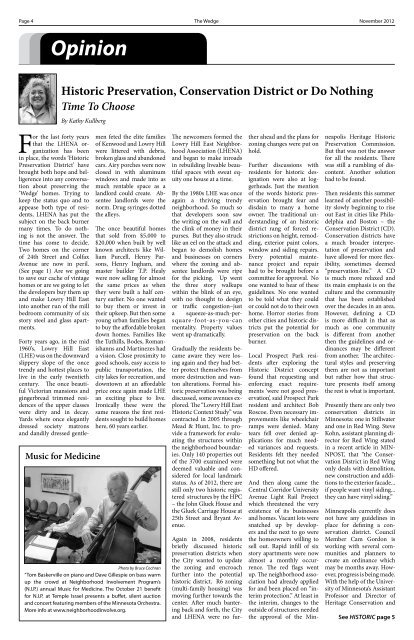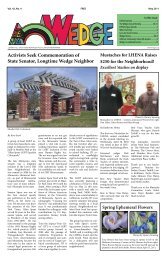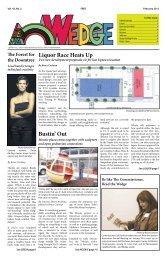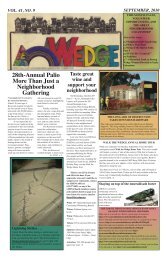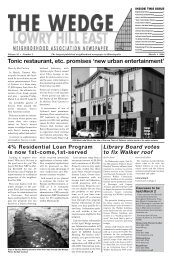Nov 2012 - Lowry Hill East Neighborhood Association
Nov 2012 - Lowry Hill East Neighborhood Association
Nov 2012 - Lowry Hill East Neighborhood Association
You also want an ePaper? Increase the reach of your titles
YUMPU automatically turns print PDFs into web optimized ePapers that Google loves.
page 4 the wedge <strong>Nov</strong>ember <strong>2012</strong> <strong>Nov</strong>ember <strong>2012</strong> the wedge page 5<br />
Opinion<br />
Historic Preservation, Conservation District or Do Nothing<br />
Time To Choose<br />
By Kathy Kullberg<br />
For the last forty years<br />
that the LHENA organization<br />
has been<br />
in place, the words ‘Historic<br />
Preservation District’ have<br />
brought both hope and belligerence<br />
into any conversation<br />
about preserving the<br />
‘Wedge’ homes. Trying to<br />
keep the status quo and to<br />
appease both type of residents,<br />
LHENA has put the<br />
subject on the back burner<br />
many times. To do nothing<br />
is not the answer. The<br />
time has come to decide.<br />
Two homes on the corner<br />
of 24th Street and Colfax<br />
Avenue are now in peril.<br />
(See page 1) Are we going<br />
to save our cache of vintage<br />
homes or are we going to let<br />
the developers buy them up<br />
and make <strong>Lowry</strong> <strong>Hill</strong> <strong>East</strong><br />
into another run of the mill<br />
bedroom community of six<br />
story steel and glass apartments.<br />
Forty years ago, in the mid<br />
1960’s, <strong>Lowry</strong> <strong>Hill</strong> <strong>East</strong><br />
(LHE) was on the downward<br />
slippery slope of the once<br />
trendy and hottest places to<br />
live in the early twentieth<br />
century. The once beautiful<br />
Victorian mansions and<br />
gingerbread trimmed residences<br />
of the upper classes<br />
were dirty and in decay.<br />
Yards where once elegantly<br />
dressed society matrons<br />
and dandily dressed gentle-<br />
Music for Medicine<br />
men feted the elite families<br />
of Kenwood and <strong>Lowry</strong> <strong>Hill</strong><br />
were littered with debris,<br />
broken glass and abandoned<br />
cars. Airy porches were now<br />
closed in with aluminum<br />
windows and made into as<br />
much rentable space as a<br />
landlord could create. Absentee<br />
landlords were the<br />
norm. Drug syringes dotted<br />
the alleys.<br />
The once beautiful homes<br />
that sold from $5,000 to<br />
$20,000 when built by well<br />
known architects like William<br />
Purcell, Henry Parsons,<br />
Henry Ingham, and<br />
master builder T.P. Healy<br />
were now selling for almost<br />
the same prices as when<br />
they were built a half century<br />
earlier. No one wanted<br />
to buy them or invest in<br />
their upkeep. But then some<br />
young urban families began<br />
to buy the affordable broken<br />
down homes. Families like<br />
the Tuthills, Bodes, Romanishanns<br />
and Martinezes had<br />
a vision. Close proximity to<br />
good schools, easy access to<br />
public transportation, the<br />
city lakes for recreation, and<br />
downtown at an affordable<br />
price once again made LHE<br />
an exciting place to live.<br />
Ironically these were the<br />
same reasons the first residents<br />
sought to build homes<br />
here, 60 years earlier.<br />
Photo by Bruce Cochran<br />
“tom baskerville on piano and dave gillespie on bass warm<br />
up the crowd at <strong>Neighborhood</strong> involvement program’s<br />
(N.i.p.) annual Music for Medicine. the october 21 benefit<br />
for N.i.p. at temple israel presents a buffet, silent auction<br />
and concert featuring members of the Minnesota orchestra.<br />
More info at www.neighborhoodinvolve.org.<br />
The newcomers formed the<br />
<strong>Lowry</strong> <strong>Hill</strong> <strong>East</strong> <strong>Neighborhood</strong><br />
<strong>Association</strong> (LHENA)<br />
and began to make inroads<br />
in rebuilding liveable beautiful<br />
spaces with sweat equity<br />
one house at a time.<br />
By the 1980s LHE was once<br />
again a thriving trendy<br />
neighborhood. So much so<br />
that developers soon saw<br />
the writing on the wall and<br />
the clink of money in their<br />
purses. But they also struck<br />
like an eel on the attack and<br />
began to demolish homes<br />
and businesses on corners<br />
where the zoning and absentee<br />
landlords were ripe<br />
for the picking. Up went<br />
the three story walkups<br />
within the blink of an eye,<br />
with no thought to design<br />
or traffic congestion–just<br />
a squeeze-as-much-persquare-foot-as-you-can<br />
mentality. Property values<br />
went up dramatically.<br />
Gradually the residents became<br />
aware they were losing<br />
again and they had better<br />
protect themselves from<br />
more destruction and wanton<br />
alterations. Formal historic<br />
preservation was being<br />
discussed, some avenues explored.<br />
The “<strong>Lowry</strong> <strong>Hill</strong> <strong>East</strong><br />
Historic Context Study” was<br />
contracted in 2005 through<br />
Mead & Hunt, Inc. to provide<br />
a framework for evaluating<br />
the structures within<br />
the neighborhood boundaries.<br />
Only 140 properties out<br />
of the 3700 examined were<br />
deemed valuable and considered<br />
for local landmark<br />
status. As of <strong>2012</strong>, there are<br />
still only two historic registered<br />
structures by the HPC<br />
– the John Gluek House and<br />
the Gluek Carriage House at<br />
25th Street and Bryant Avenue.<br />
Again in 2008, residents<br />
briefly discussed historic<br />
preservation districts when<br />
the City wanted to update<br />
the zoning and encroach<br />
further into the potential<br />
historic district. R6 zoning<br />
(multi-family housing) was<br />
moving further towards the<br />
center. After much bantering<br />
back and forth, the City<br />
and LHENA were no fur-<br />
ther ahead and the plans for<br />
zoning changes were put on<br />
hold.<br />
Further discussions with<br />
residents for historic designation<br />
were also at loggerheads.<br />
Just the mention<br />
of the words historic preservation<br />
brought fear and<br />
disdain to many a home<br />
owner. The traditional understanding<br />
of an historic<br />
district rang of forced restrictions<br />
on height, remodeling,<br />
exterior paint colors,<br />
window and siding repairs.<br />
Every potential maintenance<br />
project and repair<br />
had to be brought before a<br />
committee for approval. No<br />
one wanted to hear of these<br />
guidelines. No one wanted<br />
to be told what they could<br />
or could not do to their own<br />
home. Horror stories from<br />
other cities and historic districts<br />
put the potential for<br />
preservation on the back<br />
burner.<br />
Local Prospect Park residents<br />
after exploring the<br />
Historic District concept<br />
found that requesting and<br />
enforcing exact requirements<br />
‘were not good preservation’,<br />
said Prospect Park<br />
resident and architect Bob<br />
Roscoe. Even necessary improvements<br />
like wheelchair<br />
ramps were denied. Many<br />
tears fell over denied applications<br />
for much needed<br />
variances and requests.<br />
Residents felt they needed<br />
something but not what the<br />
HD offered.<br />
And then along came the<br />
Central Corridor University<br />
Avenue Light Rail Project<br />
which threatened the very<br />
existence of its businesses<br />
and homes. Vacant lots were<br />
snatched up by developers<br />
and the next to go were<br />
the homeowners willing to<br />
sell out. Rapid infill of six<br />
story apartments were now<br />
almost a monthly occurrence.<br />
The red flags went<br />
up. The neighborhood association<br />
had already applied<br />
for and been placed on “interim<br />
protection.” At least in<br />
the interim, changes to the<br />
outside of structures needed<br />
the approval of the Min-<br />
neapolis Heritage Historic<br />
Preservation Commission.<br />
But that was not the answer<br />
for all the residents. There<br />
was still a rumbling of discontent.<br />
Another solution<br />
had to be found.<br />
Then residents this summer<br />
learned of another possibility<br />
slowly beginning to rise<br />
out <strong>East</strong> in cities like Philadelphia<br />
and Boston – the<br />
Conservation District (CD).<br />
Conservation districts have<br />
a much broader interpretation<br />
of preservation and<br />
have allowed for more flexibility,<br />
sometimes deemed<br />
“preservation-lite.” A CD<br />
is much more relaxed and<br />
its main emphasis is on the<br />
culture and the community<br />
that has been established<br />
over the decades in an area.<br />
However, defining a CD<br />
is more difficult in that as<br />
much as one community<br />
is different from another<br />
then the guidelines and ordinances<br />
may be different<br />
from another. The architectural<br />
styles and preserving<br />
them are not as important<br />
but rather how that structure<br />
presents itself among<br />
the rest is what is important.<br />
Presently there are only two<br />
conservation districts in<br />
Minnesota: one in Stillwater<br />
and one in Red Wing. Steve<br />
Kohn, assistant planning director<br />
for Red Wing stated<br />
in a recent article in MIN-<br />
NPOST, that “the Conservation<br />
District in Red Wing<br />
only deals with demolition,<br />
new construction and additions<br />
to the exterior facade...<br />
if people want vinyl siding...<br />
they can have vinyl siding.”<br />
Minneapolis currently does<br />
not have any guidelines in<br />
place for defining a conservation<br />
district. Council<br />
Member Cam Gordon is<br />
working with several communities<br />
and planners to<br />
create an ordinance which<br />
may be months away. However,<br />
progress is being made.<br />
With the help of the University<br />
of Minnesota’s Assistant<br />
Professor and Director of<br />
Heritage Conservation and<br />
See HISTORIC page 5<br />
HISTORIC from page 4<br />
Preservation Greg Donofrio,<br />
it is getting closer.<br />
“People don’t like that they<br />
can’t do whatever they want.<br />
The downside is there are<br />
encumbrances. The upside,<br />
is maintaining the community,”<br />
said Prospect Park<br />
resident, Joe Ring.<br />
Conservation District<br />
versus Historic<br />
District<br />
Similarities<br />
• Both a CD and HD are defined<br />
by the local city regulatory<br />
processes providing<br />
guidelines for residential<br />
remodeling of exteriors in<br />
public view only through<br />
building permit review.<br />
• City ordinances establish<br />
its regulatory and/or advisory<br />
role in various processes,<br />
principally in building<br />
permit review.<br />
• CD and HD are typically<br />
authorized under State of<br />
Minnesota enabling legislation.<br />
• A single ordinance would<br />
apply to all CDs, as they do<br />
HDs within a city, while<br />
each district has its own<br />
guidelines addressing that<br />
district’s characteristics.<br />
Differences<br />
In Conservation Districts:<br />
• The CD establishes guidelines<br />
for review of design<br />
changes to promote good<br />
neighbors in terms of general<br />
architectural features.<br />
The guidelines would not<br />
allow disruptive alterations<br />
LOOKING from page 2<br />
for the Tennessee Whiskey<br />
Cake next time: apple caramel<br />
cake covered in a Jack<br />
Daniel’s whiskey glaze. Yep.<br />
Doin’ that.<br />
All in all, we’d come back<br />
again. The food was excellent,<br />
the service was good<br />
for the most part, and there’s<br />
but allow change with flexible<br />
outcomes.<br />
• CDs may have potential<br />
for introducing creative approaches<br />
to design that contribute<br />
to the streetscape<br />
and community.<br />
• CDs often seek some level<br />
of maintaining historic resources.<br />
• CDs consider stability of<br />
community values as their<br />
most important public role.<br />
The are regarded to have<br />
more flexibility in addressing<br />
change.<br />
In Historic Districts:<br />
• A local city regulatory<br />
process provides guidelines<br />
for residential remodeling<br />
of exteriors in public view<br />
only through building permit<br />
review. The HD establishes<br />
guidelines for adherence<br />
to changes affecting<br />
recognized architectural<br />
styles of historic resources.<br />
Character-defining features<br />
critical to the design are<br />
strictly reviewed to maintain<br />
their integrity.<br />
• HDs by their nature do<br />
not encourage creative approaches,<br />
as a general rule,<br />
but sometimes encourage<br />
creative solutions depending<br />
on certain circumstances.<br />
• HDs seek to maintain historic<br />
resources.<br />
• Historic Districts consider<br />
stability of community values<br />
as their most important<br />
public role. They require the<br />
exercise of firmness in addressing<br />
change.<br />
The Stillwater CD Design<br />
a surprisingly large outdoor<br />
patio we’re interested in trying,<br />
with half-moon booths<br />
and fire pits. And although<br />
it’s having an identity crisis,<br />
Bar Louie seems to be finding<br />
its way just fine.<br />
(Beth Marsh is taking a<br />
month off. Her column will<br />
return in December.)<br />
Letters to the Editor and<br />
Community Voices and Opinions<br />
We value your insights and points of view.<br />
Please send letters to the editor or longer opinion<br />
pieces to weg612@hotmail.com<br />
Guildelines states: A Residential<br />
CD has been established<br />
to help protect and<br />
preserve the unique character<br />
of Stillwater’s residential<br />
neighborhoods, by<br />
regulating and providing<br />
Design Guidelines for new<br />
infill development within<br />
the District. Its purpose<br />
is to conserve the traditional<br />
neighborhood fabric,<br />
guide future infill development<br />
within the district,<br />
and discourage unnecessary<br />
demolition of structures<br />
that contribute to the<br />
district’s historic character.<br />
A Conservation District<br />
helps preserve local character,<br />
neighborhood pride,<br />
and property values. It also<br />
helps promote and sustain a<br />
diverse and affordable range<br />
of homes, and the general<br />
economic vitality of the<br />
area. Looking to Stillwater,<br />
LHENA may have finally<br />
found a solution.<br />
Want to hear more about<br />
how a CD for <strong>Lowry</strong> <strong>Hill</strong><br />
<strong>East</strong> can help preserve further<br />
erosion of our century<br />
structures while providing<br />
for flexible and creative solutions<br />
to building problems<br />
that work for the whole<br />
neighborhood? A LHENA<br />
meeting is being planned for<br />
after the winter holidays. A<br />
team of experts will present<br />
the differences as well as answer<br />
questions. Hopefully by<br />
that time City Council member<br />
Cam Gordon will have<br />
updates on the ordinance’s<br />
status. For more information<br />
you may contact Kathy Kullberg<br />
at 612.374.4456.<br />
Kathy Kullberg is an historian<br />
and lives in <strong>Lowry</strong> <strong>Hill</strong><br />
<strong>East</strong>.<br />
Compliments<br />
Opinion<br />
LETTER TO THE EDITOR<br />
I’ve been so impressed<br />
lately with the quality of<br />
writing and quality of information<br />
put out by the<br />
paper and its writers.<br />
Please pass along my compliments<br />
to the following<br />
contributors:<br />
Kathy Kullberg, our historian<br />
for her passion about<br />
neighborhood history and<br />
wonderful writing skills<br />
in giving us so much we<br />
wouldn’t otherwise know.<br />
Rebecca Harnik, Environmental<br />
Coordinator, for<br />
Mingling at Rye<br />
“I love being on the<br />
school board. I will<br />
continue to work<br />
tirelessly on your<br />
behalf towards seeing<br />
that every community<br />
has great schools and<br />
every student<br />
has great teachers.”<br />
— Carla Bates<br />
giving us the skinny on<br />
what we need to know to<br />
live more sustainably on<br />
Mother Earth in our city<br />
lives.<br />
KTK9 for reminding us of<br />
the common sense many<br />
of us don’t use regarding<br />
dog ownership, and doing<br />
it in no-nonsense language.<br />
Very effective.<br />
And kudos to Caroline for<br />
her constancy and a job<br />
well done all these years.<br />
She is the glue.<br />
Linda Huhn<br />
<strong>Lowry</strong> <strong>Hill</strong> <strong>East</strong> resident<br />
Photo by Bruce Cochran<br />
“Monday Night Mingle participants connected with neighbors,<br />
enjoyed complimentary appetizers, and checked out rye delicatessen<br />
and bar, 1930 Hennepin ave. Everyone enjoyed the<br />
Uptown association’s evening of new foods, drinks, friends and<br />
business connections. see www.uptownminneapolis.com for a<br />
calendar of upcoming events.<br />
Educational Experience<br />
Expertise<br />
Excellence<br />
RE-ELECT<br />
carla<br />
bates<br />
for minneapolis school board<br />
DFL ENDORSED<br />
Prepared and paid for by the Carla Bates for Minneapolis Schools<br />
committee, 2504 37th Avenue South, Minneapolis, MN 55406


